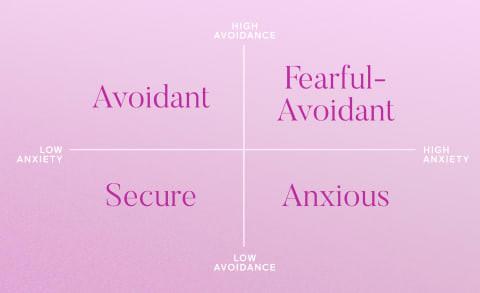The 4 Attachment Style (With tips on how to overcome the unhealthy)
Curated from: mindbodygreen.com
Ideas, facts & insights covering these topics:
10 ideas
·7.26K reads
52
1
Explore the World's Best Ideas
Join today and uncover 100+ curated journeys from 50+ topics. Unlock access to our mobile app with extensive features.
An attachment style is a specific pattern of behavior in and around relationships.
According to attachment theory, first developed by psychologist Mary Ainsworth and psychiatrist John Bowlby in the 1950s, a person's attachment style is shaped and developed in early childhood in response to their relationships with their earliest caregivers.
59
918 reads
1. Secure attachement, the healthy ideal of relationship
- Childhood source: when caregivers consistently fulfill a baby’s physical and emotional needs
- Adulthood charactrristics: able to trust others and be trusted, love and accept love, and become close to others with relative ease.
They're not afraid of intimacy, nor do they feel panicked when their partners need time or space away from them. They're able to depend on others without becoming totally dependent
57
830 reads
Tips for people with secure attachement style
A secure attachment style doesn’t mean you can take for granted that your relationships will be smooth sailing. If two securely attached people are in a relationship, they’re starting out from a better position, but relationships take work for everyone, no matter your attachment style.
55
761 reads
2. Anxious attachement or anxious-preoccupied attachment
- Childhood source: When primary caregivers aren’t consistent in meeting a baby’s needs
- Deepest fear: Abandonement
- Adulthood characteristics: neediness or clingy behaviour
People with an anxious attachment style tend to be very insecure about their relationships, often worrying that their partner will leave them and thus always hungry for validation.
62
812 reads
Tips to help them to feel confident
People with an anxious attachment can benefit from what we call ‘rituals of separation, like texting during the day to tell that we're thinking of them. They make a conscious effort to acknowledge that they’re leaving and also that they will be back.
60
721 reads
3. Avoidant attachement or dismissive-avoidant attachment
- Childhood source: when a caregiver doesn’t provide a baby with sufficient emotional support
- Deepest fear: Intimacy
- Adulthood characteristics distant, emotionally unavailable, may find relationships suffocating and avoid them completely, preferring to be independent and rely on themselves.
People with an avoidant attachment style tend to have trouble getting close to others or trusting others in relationships, because they ultimately don't believe their needs can get met in a relationship.
55
743 reads
Tips for people with avoidant attachement style
Actively observing your own emotions and considering how you pull away from others will require a lot of work. But that effort can be an eye-opening way to help understand your style and learn to let others in.
59
638 reads
4. Fearful-avoidant attachment,
(the combination of both the anxious and avoidant attachment styles)
- Childhood source: forms through a particularly tumultuous childhood, often one that may be marked by fear or trauma
- Adulthood characteristics: difficulty regulating emotions, heightened sexual behavior, and increased risk for violence in their relationships.
They are reluctant to develop a close romantic relationship, yet at the same time, feel a dire need to feel loved by others
62
649 reads
Tips for people whith fearful-avoidant attachement
Some people who have a disorganized attachment style can often benefit from dialectical behavior therapy (DBT), a type of talk therapy that’s especially helpful for people who experience very intense emotions.
58
624 reads
IDEAS CURATED BY
CURATOR'S NOTE
The way our caregiver may treat us during childhood can have a big impact on how we manage relationship, our attachement style
“
's ideas are part of this journey:
Learn more about parenting with this collection
How to develop a healthy relationship with money
How to create a budget
The impact of emotions on financial decisions
Related collections
Similar ideas
1 idea
Attachment Theory: Overview and Implications - The Human Condition
thehumancondition.com
8 ideas
How Attachment Styles Affect Adult Relationships
helpguide.org
15 ideas
Read & Learn
20x Faster
without
deepstash
with
deepstash
with
deepstash
Personalized microlearning
—
100+ Learning Journeys
—
Access to 200,000+ ideas
—
Access to the mobile app
—
Unlimited idea saving
—
—
Unlimited history
—
—
Unlimited listening to ideas
—
—
Downloading & offline access
—
—
Supercharge your mind with one idea per day
Enter your email and spend 1 minute every day to learn something new.
I agree to receive email updates





